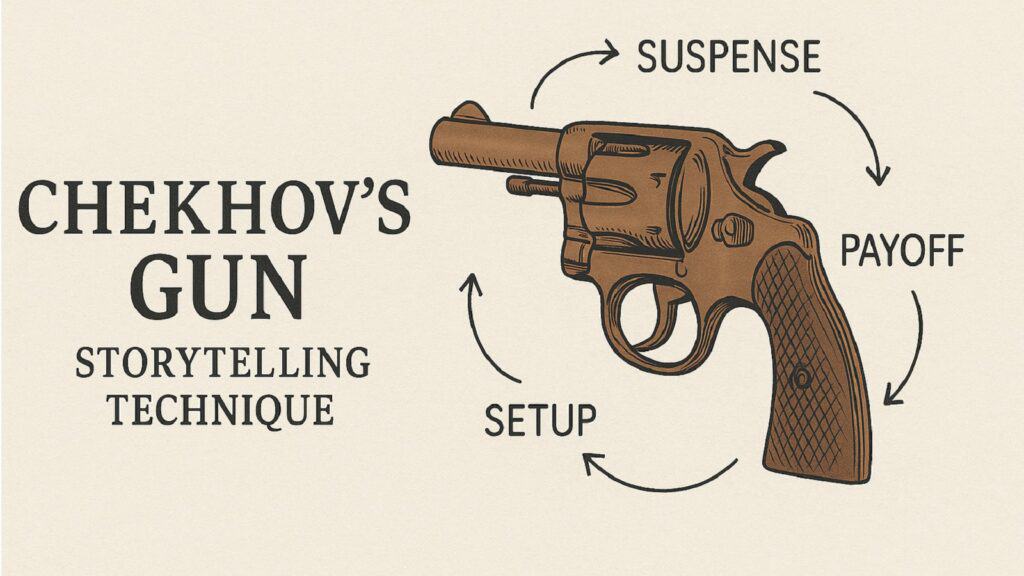Table of Contents
Introduction – Why Chekhov’s Gun Still Fires in Every Great Story
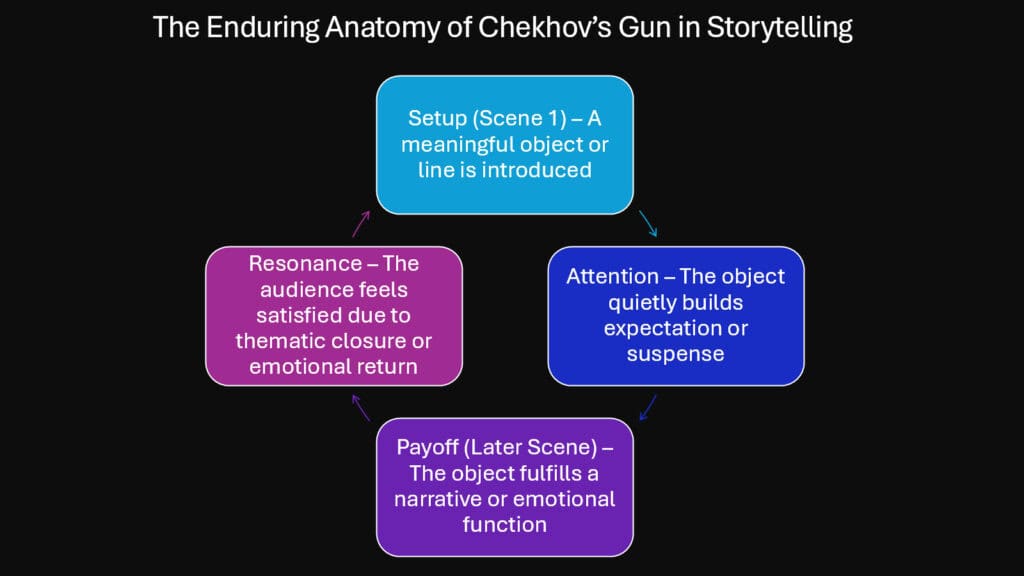
When Anton Chekhov penned his famous letter in 1889, declaring that a gun introduced in the first act must fire by the third, he unknowingly created one of literature’s most enduring principles. This seemingly simple rule has shaped storytelling across cultures and centuries, transforming how writers approach narrative construction. From the bustling markets of Lagos to the neon-lit streets of Tokyo, Chekhov’s Gun continues to influence authors who understand that every element in a story must serve a purpose.
The principle extends far beyond literal firearms. It encompasses any object, character trait, or detail that writers introduce with deliberate intention. When Haruki Murakami places a mysterious well in his narratives, or when Chinua Achebe mentions ancestral masks in his village scenes, these elements carry the weight of future significance. The gun becomes a metaphor for narrative efficiency, demanding that writers respect their readers’ attention and investment.
Modern storytelling has embraced this storytelling technique across diverse mediums. Korean screenwriters crafting intricate K-dramas understand that the casual mention of a family heirloom in episode one will resurface with devastating emotional impact later. Indian filmmakers weave traditional elements like ceremonial swords or forgotten letters into their narratives, knowing these objects will return to drive crucial plot developments. The principle transcends cultural boundaries because it speaks to something fundamental about human psychology and our need for coherent, meaningful experiences.
This exploration reveals six powerful ways Chekhov’s Gun continues to reload narrative power in contemporary storytelling. From establishing narrative economy to subverting modern expectations, this technique remains as sharp and effective as ever. Each application demonstrates how writers worldwide have adapted this Russian playwright’s wisdom to their unique cultural contexts while maintaining its essential truth about purposeful storytelling.
Table 1: Chekhov’s Gun Across Literary Traditions
| Literary Tradition | Common Gun Elements | Purpose in Narrative |
|---|---|---|
| African Literature | Ancestral artifacts, ceremonial objects | Cultural continuity and spiritual awakening |
| Asian Literature | Family heirlooms, calligraphy scrolls | Honor, memory, and generational wisdom |
| Latin American Literature | Religious icons, folk instruments | Magical realism and cultural identity |
| European Literature | Letters, jewelry, weapons | Character revelation and plot resolution |
| Australian Literature | Indigenous tools, landscape elements | Connection to land and heritage |
1. Chekhov’s Gun and the Law of Narrative Economy
Narrative economy operates on the principle that every story element must justify its existence through meaningful contribution to the overall arc. This literary framework demands ruthless efficiency, where details survive only if they advance character development, plot progression, or thematic resonance. Chekhov’s Gun serves as the enforcement mechanism for this economy, ensuring that writers cannot indulge in meaningless decoration that clutters the narrative landscape.
Consider how Gabriel García Márquez employs this principle in his magical realism. When he introduces yellow butterflies in his stories, these creatures inevitably return to mark moments of profound transformation or death. The butterflies are never mere atmospheric details but carefully planted elements that will bloom into significance. Similarly, when Toni Morrison mentions a particular song or piece of clothing in her narratives, these objects carry forward the weight of memory and trauma, returning to illuminate character psychology at crucial moments.
The framework becomes particularly evident in detective fiction across cultures. When Agatha Christie places a seemingly innocent teacup on a side table, readers familiar with narrative economy understand its future importance. Japanese mystery writers like Seishi Yokomizo follow similar patterns, where traditional items like folding fans or family crests introduced early in their stories inevitably become central to solving the mystery. This method honors the intelligence of readers while preserving narrative tension.
Contemporary authors have refined this technique further. Chimamanda Ngozi Adichie introduces cultural objects like traditional fabrics or family photographs that seem incidental but later become powerful symbols of identity and loss. The narrative economy principle ensures that these elements earn their place through emotional and thematic payoff rather than mere cultural color. Writers learn to view their stories as ecosystems where every element must contribute to the whole or face elimination.
Table 2: Narrative Economy Applications
| Literary Theory Element | Function in Story | Chekhov’s Gun Role |
|---|---|---|
| Character Props | Reveal personality traits | Future character development catalyst |
| Setting Details | Establish atmosphere | Plot-driving environmental factors |
| Dialogue References | Provide exposition | Foreshadowing key revelations |
| Cultural Artifacts | Ground story in context | Symbol transformation mechanisms |
| Background Events | Build world complexity | Future conflict sources |
2. Chekhov’s Gun Creates Emotional Boomerangs
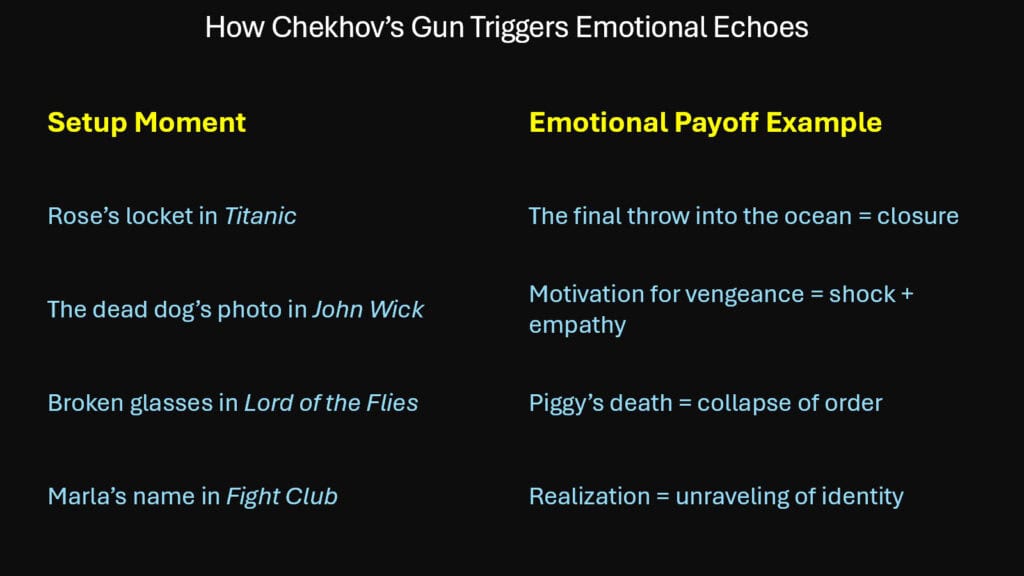
Stories achieve their deepest impact when seemingly minor elements return with amplified emotional weight, creating what can be understood as emotional boomerangs. These narrative devices travel outward from their initial introduction, gather emotional energy throughout the story, and return to strike readers with accumulated force. Chekhov’s Gun provides the launching mechanism for these emotional projectiles, ensuring their initial placement feels natural while maximizing their eventual impact.
Chekhov’s Gun technique manifests powerfully in works like Isabel Allende’s novels, where family recipes mentioned in passing become vehicles for profound grief and remembrance. When a grandmother’s empanada recipe resurfaces during a moment of loss, it carries with it the weight of tradition, love, and irreversible change. The recipe was never just culinary instruction but an emotional time bomb waiting for the perfect moment to detonate meaning.
African writers like Ngũgĩ wa Thiong’o often plant traditional songs or proverbs early in their narratives. These cultural elements seem to provide authentic atmosphere initially, but they return during climactic moments to deliver devastating emotional truths about identity, resistance, or loss. The songs carry the voices of ancestors and the weight of collective memory, transforming from background culture to foreground revelation.
Table 3: Chekhov’s Gun and Emotional Boomerang Patterns
| Initial Introduction | Emotional Development | Return Impact |
|---|---|---|
| Casual family mention | Character attachment building | Devastating loss revelation |
| Traditional object reference | Cultural significance layering | Identity crisis resolution |
| Childhood memory fragment | Nostalgia and innocence association | Adult disillusionment moment |
| Natural element description | Peace and stability connection | Disruption and change symbol |
| Simple gesture portrayal | Love and care demonstration | Absence and regret amplification |
3. Chekhov’s Gun and Aristotle’s Unified Structure
Aristotle’s Unity of Action demands that every element in a narrative contribute to a single, cohesive storyline where events flow logically from one to the next. This traditional framework aligns seamlessly with Chekhov’s Gun, which guarantees that the elements introduced contribute to a cohesive structure instead of generating arbitrary digressions. The combination creates stories where causality reigns supreme and coincidence feels earned rather than convenient.
The unified structure principle becomes particularly visible in works like Chinua Achebe’s narratives, where traditional Igbo cultural elements introduced early in the story inevitably become central to the protagonist’s internal and external conflicts. When Achebe mentions ancestral customs or tribal artifacts, these elements later emerge as crucial factors in character decisions and plot developments. Nothing exists merely for cultural decoration; everything serves the unified action.
Similarly, contemporary Chinese authors like Mo Yan employ this principle by introducing seemingly minor political or social details that later become major plot drivers. A casual reference to a local official’s corruption or a traditional festival custom will inevitably return to influence character fates and story resolution. The unified structure ensures that these elements feel inevitable rather than forced when they reassert their importance.
Japanese literature demonstrates this unity through subtle seasonal references or cultural practices that seem atmospheric initially but become central to character psychology and plot development. When Yasunari Kawabata mentions cherry blossoms or tea ceremony details, these elements integrate into the story’s emotional and thematic architecture, supporting the unified action rather than decorating around it.
The framework requires writers to think architecturally about their narratives, ensuring that early installations support later developments. Every element must bear structural weight in the story’s edifice, contributing to the unified action that Aristotle championed as essential for powerful storytelling.
Table 4: Unified Structure Elements and Functions of Chekhov’s Gun
| Aristotelian Principle | Chekhov’s Gun Function | Narrative Result |
|---|---|---|
| Beginning Setup | Element introduction | Foundation establishment |
| Middle Development | Element significance building | Causal chain strengthening |
| End Resolution | Element payoff delivery | Unified action completion |
| Character Arc | Personality trait revelation | Growth catalyst provision |
| Plot Progression | Obstacle or solution placement | Logical development insurance |
4. Chekhov’s Gun Makes Symbolism Feel Inevitable
The transformation of ordinary objects into profound symbols requires careful cultivation throughout a narrative, and Chekhov’s Gun provides the perfect mechanism for this metamorphosis. Unlike heavy-handed symbolism that announces its importance, this technique allows meaning to accumulate naturally around objects, making their symbolic weight feel inevitable rather than imposed. The gun acts as a catalyst for symbolic development.
Octavio Paz excelled in this technique in his poetry and prose, where commonplace Mexican items such as mirrors, water containers, or traditional masks progressively gain symbolic significance. These items begin as concrete reality but slowly gather metaphorical significance through repeated appearance and association with key themes. By the story’s end, these objects carry enormous symbolic weight that feels earned rather than assigned.
Australian Aboriginal writers demonstrate similar techniques when they introduce elements from the natural landscape. A particular tree, rock formation, or animal mentioned early in the story begins as geographical detail but evolves into a symbol of connection, spirituality, or cultural continuity. The transformation happens gradually through association with character experiences and thematic development.
Korean authors like Han Kang excel at this symbolic evolution, introducing objects like flowers, food items, or household tools that seem mundane initially but become powerful symbols of oppression, resistance, or transformation. The objects acquire symbolic meaning through their association with character psychology and social commentary, never feeling forced or artificially imposed.
Chekhov’s Gun technique requires patience and subtlety from writers who must resist the urge to announce symbolic significance. Instead, they allow meaning to accumulate naturally through repetition, association, and contextual development. The symbols emerge organically from the narrative soil rather than being planted fully formed.
Table 5: Chekhov’s Gun and Symbolic Evolution Process
| Evolution Stage | Object Function | Reader Recognition |
|---|---|---|
| Introduction | Literal presence | Concrete understanding |
| Development | Pattern establishment | Subconscious association |
| Association | Thematic connection | Emerging awareness |
| Accumulation | Meaning layering | Growing significance |
| Revelation | Full symbolic weight | Complete understanding |
5. Chekhov’s Gun and Structuralism’s Code of Significance
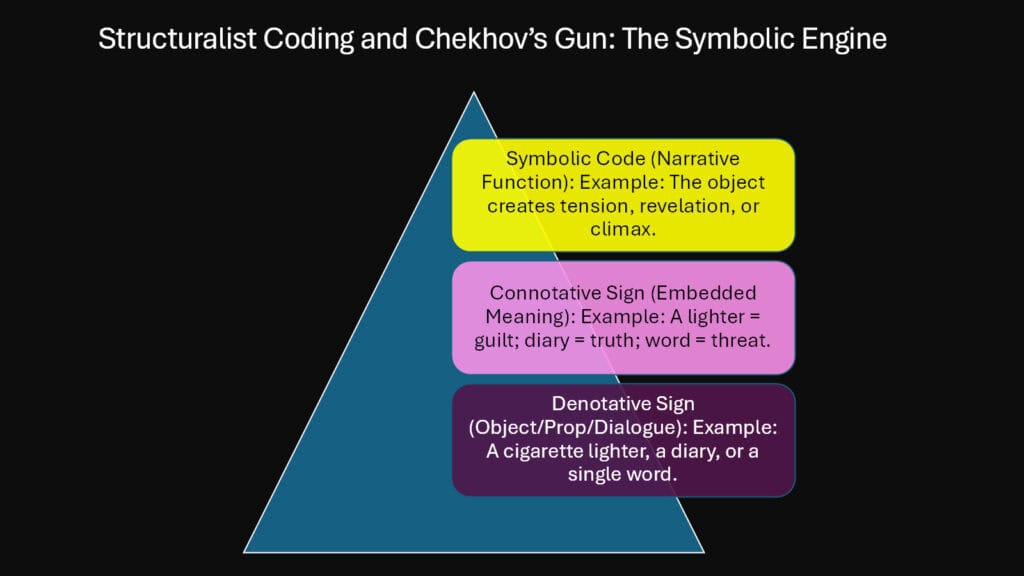
Structuralist theory reveals how narratives operate through coded systems where certain elements signal importance while others provide background noise. Chekhov’s Gun functions as a master encoder, marking specific elements for future significance while maintaining their surface innocence. This coding system allows writers to communicate with readers on multiple levels, creating narratives that reward careful attention while remaining accessible to casual consumption.
The coding mechanism operates through subtle signals that experienced readers learn to recognize. When Italo Calvino introduces a particular book, map, or mechanical device in his stories, the careful reader understands that these objects carry coded significance beyond their immediate function. The coding doesn’t announce itself but operates through placement, description detail, and character interaction patterns.
Latin American authors like Jorge Luis Borges perfected this coded approach, where libraries, mirrors, and labyrinths function simultaneously as literal story elements and coded symbols of infinite regress, reflection, and complexity. The codes operate through cultural and literary associations that reward educated readers while never excluding those who read for surface narrative alone.
Contemporary African authors employ similar coding techniques with traditional objects, ceremonies, and social practices that signal cultural significance to readers familiar with the codes while remaining accessible as story elements to others. The double-layered communication allows stories to speak to multiple audiences simultaneously without sacrificing narrative coherence.
The structuralist framework reveals how these codes create meaning through difference and relationship rather than inherent properties. A knife becomes significant not because knives are inherently meaningful but because this particular knife receives coded treatment that distinguishes it from other story elements. The coding system transforms ordinary objects into narrative significance carriers.
Table 6: Chekhov’s Gun and Structuralist Coding Elements
| Code Type | Narrative Function | Reader Response |
|---|---|---|
| Cultural Codes | Social meaning conveyance | Community recognition |
| Literary Codes | Intertextual significance | Educated appreciation |
| Symbolic Codes | Metaphorical weight bearing | Interpretive engagement |
| Action Codes | Plot development signaling | Tension anticipation |
| Hermeneutic Codes | Mystery element marking | Solution expectation |
6. Chekhov’s Gun Subverts Modern Expectations
Contemporary storytelling has begun to playfully subvert the traditional Chekhov’s Gun principle, using reader expectations about the technique to create surprise and commentary on narrative conventions themselves. This meta-textual approach acknowledges the principle’s ubiquity while exploring what happens when the gun doesn’t fire as expected, creating new forms of narrative tension and reader engagement.
Postmodern authors like Paul Auster deliberately introduce elements that seem to promise future significance but then abandon them without resolution, creating anxiety and commentary about the artificial nature of narrative closure. These false guns challenge readers to examine their assumptions about story structure and meaning-making while creating genuine emotional responses to narrative uncertainty.
Contemporary genre fiction has embraced delayed firing mechanisms where the gun introduced in chapter one doesn’t fire until the final book of a series, testing reader patience and memory while building enormous anticipation. Writers like Tana French plant evidence and clues that remain dormant across multiple novels before achieving their intended impact, expanding the traditional time frame for Chekhov’s Gun operation.
Some modern authors employ multiple false guns to hide the real one, creating complex patterns of expectation and misdirection. They introduce several potentially significant elements, allowing some to fire as expected while leaving others as red herrings, training readers to question their assumptions about narrative importance and creating more sophisticated reading experiences.
The subversion technique necessitates a profound comprehension of conventional principles prior to making effective attempts to dismantle them. Writers must establish credibility through conventional storytelling before earning the right to experiment with reader expectations. The most successful subversions honor the original principle while expanding its possibilities.
Table 7: Chekhov’s Gun and Modern Subversion Techniques
| Subversion Type | Traditional Expectation | Modern Twist |
|---|---|---|
| Delayed Fire | Immediate story resolution | Extended series payoff |
| False Gun | Significant element firing | Deliberate abandonment |
| Multiple Guns | Single clear significance | Complex misdirection pattern |
| Meta Commentary | Invisible technique | Self-aware narrative discussion |
| Genre Blending | Convention following | Expectation mixing |
Conclusion – Chekhov’s Gun as a Quiet Revolution in Storytelling
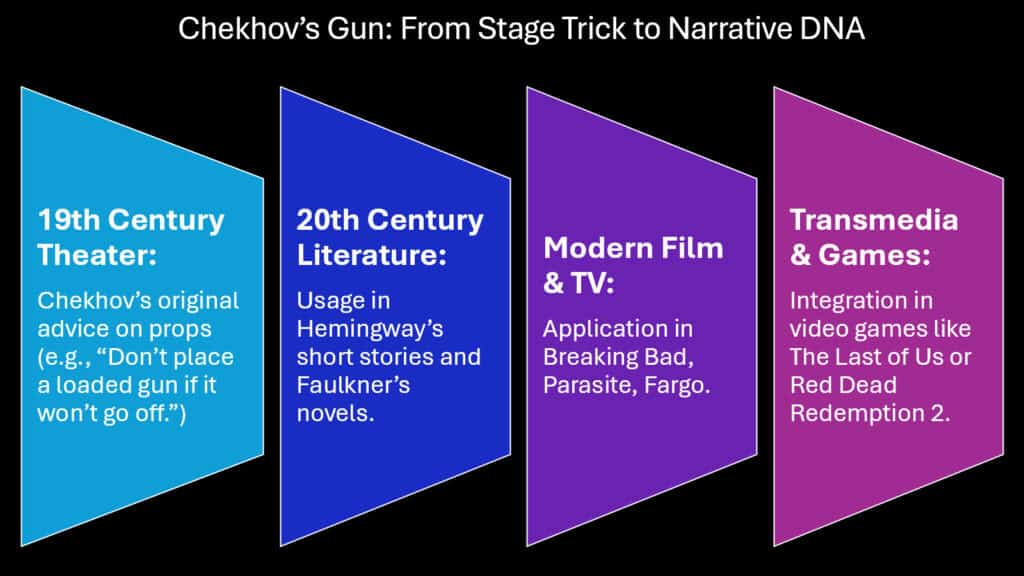
The enduring power of Chekhov’s Gun lies not in its simplicity but in its profound understanding of human psychology and narrative necessity. This technique has quietly revolutionized storytelling by establishing a contract between writers and readers based on trust, efficiency, and respect for attention. From its origins in Russian theater to its current applications across global media, the principle has adapted to new contexts while maintaining its essential truth about purposeful narrative construction.
The technique’s influence extends far beyond literature into film, television, and digital storytelling, where attention spans have shortened but the need for meaningful narrative coherence has only intensified. Contemporary creators worldwide have discovered that Chekhov’s Gun provides a framework for creating satisfying stories regardless of cultural context or medium limitations. The principle transcends artistic boundaries because it addresses fundamental human needs for pattern, purpose, and payoff in narrative experiences.
Modern applications have expanded the concept’s scope while preserving its core wisdom. Whether firing traditionally, subverting expectations, or operating through coded systems, the technique continues to evolve with changing storytelling landscapes. Writers have learned to use it as both tool and inspiration, creating narratives that honor reader intelligence while delivering emotional and intellectual satisfaction.
The quiet revolution continues as new generations of storytellers discover this principle’s power to transform scattered elements into unified artistic experiences. The gun that Chekhov loaded more than a century ago continues to fire in stories across cultures, languages, and mediums, proving that great storytelling principles transcend their historical origins to become eternal tools for human connection and understanding.
Table 8: Chekhov’s Gun Evolution Timeline
| Era | Primary Application | Cultural Impact |
|---|---|---|
| Classical Period | Theater efficiency | Dramatic economy establishment |
| Modern Literature | Novel construction | Narrative sophistication advancement |
| Contemporary Fiction | Genre storytelling | Reader expectation management |
| Digital Age | Multimedia narratives | Cross-platform coherence |
| Global Era | Cultural adaptation | Universal storytelling principles |

